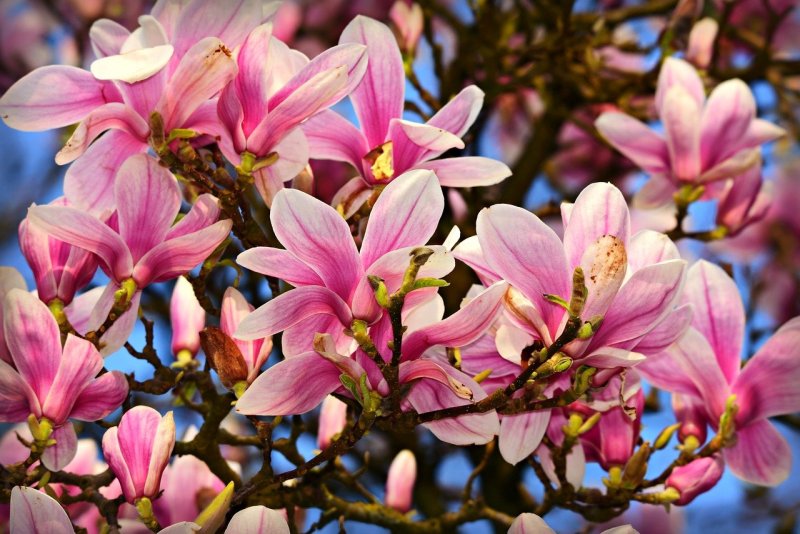Magnolia trees are most recognizable by their beautiful flowers, decadent scent, and glossy green leaves. The magnolia flower can be large and showy, or petite and abundant. Others grow into large shade trees, and yet others are used as evergreen shrubs, trees or hedges. They’re very easy to care for, resistant to many diseases and pests, beloved by migrating birds, and depending on the variety, tolerant of harsh Southern summers and cold Northern winters. The iconic southern magnolia (Magnolia grandiflora) is the most well-known. However, deciduous varieties of the magnolia tree is a flowering plant that can be grown in almost any region of the U.S. With over 200 varieties, there is certainly a breathtaking magnolia tree that will thrive in your yard!
A Brief History
Magnolia is named after French botanist Pierre Magnol who admired the tree so much that he transplanted it to Europe 300 years ago. The magnolia is also an ancient genus. It can be traced back before bees! The flowers are said to have evolved to encourage pollination by beetles. In order to avoid damage from the pollinating beetles, the reproductive structures of Magnolia flowers are extremely tough. In fact , there are even certain species that have evolved into evergreens.
Best Magnolia Trees For Every Location

Shutterstock/HAYAO
Southern Magnolia
With the floral name, Magnolia grandiflora, this beauty is the most common variety. So if you hear someone talking about a magnolia tree, this is probably the one they’re referring to! Its large, creamy white and very fragrant flowers grace this broad leafed evergreen in late spring and early summer.
- Zone(s): 6-10
- Mature Size: 60-80 ft.
- Sun Preference: Full sun and partial shade
- Soil Preference: Acidic, loamy, moist, sandy, well-drained and clay soils
- Watering: Can withstand some flooding and has moderate drought tolerance

Shutterstock/Branko Srot
Saucer Magnolia
Also known as Magnolia x soulangiana, the saucer magnolia is a deciduous trees known as the pink magnolia tree. Its spectacular flowers that appear in late winter and early spring. Saucer magnolias are small, low-branched trees with large, saucer-shaped flowers. The fragrant, early-spring flowers are white shaded with light to deep pink or purplish-pink. Its big, broad leaves are dark green, and the smooth bark is silvery-gray.
- Zone(s): 4-9
- Mature Size: 20-30 ft.
- Sun Preference: Full sun
- Soil Preference: Acidic, loamy, moist, sandy, well-drained and clay soils
- Watering: Has some drought tolerance

Shutterstock/Igor Krasilov
Star Magnolia
Also called Magnolia stellata, star magnolias bloom fragrant white flowers. This hardy magnolia can easily be used as a single specimen or a foundation planting. They have dark green leaves with striking, gray bark. Star magnolias are deciduous and can be a small tree or a large shrub.
- Zone(s): 4-9
- Mature Size: 15-20 ft.
- Sun Preference: Full sun and partial shade
- Soil Preference: Acidic, loamy, moist, sandy, well-drained and clay soils
- Watering: Can withstand some flooding and has moderate drought tolerance

Shutterstock/SnowMannn
Magnolia Kobus
Magnolia kobus is a small to medium deciduous magnolia or large shrub that is native to forest areas in Japan. As a tree, it is pyramidal when young, maturing to a spreading, dense, rounded form. It is known for its late winter to early spring bloom of goblet-shaped, fragrant, often pink-tinged, white flowers.
- Zone(s): 5-8
- Mature Size: 25-30 ft.
- Sun Preference: Full sun and partial shade
- Soil Preference: Acidic, loamy, moist, sandy, well-drained and clay soils
- Watering: Can withstand some flooding and has moderate drought tolerance

Shutterstock/Monika Valachovic
Jane Magnolia
As a member of the “Little Girl” group of hybrid magnolia, Jane Magnolias are large deciduous shrubs or small trees that bloom an abundance of pink to reddish-purple flowers in April and early May, just before the leaves appear. Jane magnolias are native to southwest China, but have been cultivated across all of China and Japan for several centuries. The flowers are a gorgeous tulip shape with a lightly scented fragrance. Its leaves are dark green and somewhat leathery in appearance. They are a great choice for any accent or border of your home!
- Zone(s): 4-7
- Mature Size: 10-15 ft.
- Sun Preference: Full sun
- Soil Preference: Acidic, loamy, moist, rich, sandy, silty loam and well-drained soils.
- Watering: Sensitive to drought and flooding

Shutterstock/RupeshKumar
Sweetbay Magnolia
All magnolias have unusual, exotic-looking cones, but those on a sweetbay magnolia (Magnolia virginiana) are showier than most. Sweetbay magnolia trees feature creamy white spring and summer flowers with a lemony fragrance and bright scarlet-red seeded fruit that ripens in the late summer, attracting many birds. They create less mess than other magnolia tree species which makes sweetbay magnolias perfect for narrow spaces, patios, or urban areas where you need a compact tree.
- Zone(s): 5-10
- Mature Size: 10-20 ft.
- Sun Preference: Full sun and partial shade
- Soil Preference: Acidic, loamy, moist, rich, sandy, silty loam, well-drained and wet soils
- Watering: Can tolerate periodic flooding

Shutterstock/Tim Gray
Cucumber Magnolia
Also known as, Magnolia acuminata, commonly known as a cucumber tree, are native to eastern North America, reaching its largest size in the southern Appalachian Mountains. It is the only magnolia that is native to Missouri where it typically occurs in moist soils in wooded valleys and along the Mississippi River. The name comes from for the green, warty, cucumber-like fruits that follow the flowers. It is a deciduous magnolia that produces slightly-fragrant, greenish-yellow, tulip-like flowers in late spring. It is used for shade and flowering.
- Zone(s): 3-8
- Mature Size: 40-70 ft.
- Sun Preference: Full sun and partial shade
- Soil Preference: Moist, rich, and well-drained loams
- Watering: Intolerant to either dry or wet extremes
